Let’s hope – for all the curveballs that 2020 threw our way – that one of the unexpected benefits of this tumultuous year has been a little more time to tick some books off your reading list. Last year at this time, we recommended a number of then-forthcoming titles for CIOs looking to take a deeper dive into technology topics, from AI to the ins and outs of technology experimentation and innovation.
This year, we are again offering up our recommended technology reads for the new year, beginning with an overview of the technology likely to top the agenda in 2021.
Our book recommendations also include explorations of the social nature of next-gen robots and smart products, the crucial role of design in the digital era, an examination of the very real AR and VR entering the enterprise, new looks at agile transformation and the critical role of developers, a warning about the shortcomings of machine learning, and a couple of rich how-to tomes for fueling imagination and innovation in an organization.
[ Read also: 10 leadership books to stretch your skills in 2021 and How to build strong teams: 8 must-read books. ]
Let’s dig in:
The Year in Tech 2021: Tools for Preparing Your Team for the Future
By: Harvard Business Review (HBR), David Weinberger, Tomas Chamorro-Premuzic, Darrell K. Rigby, and David Furlonger
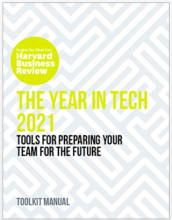
Book description (via the Harvard Business Review Store): “Business is changing. Will you adapt or be left behind? In “The Year in Tech, 2021: Tools for Preparing Your Team for the Future,” you’ll apply the ideas from “The Year in Tech, 2021: The Insights You Need from Harvard Business Review” to help your team (and you) better understand the fast-moving issues around technological innovation, how it affects your company and your industry, and what you need to do now to prepare your company for the future.”
Why you should read it: This two-for-one is already out and offers up a look at the technology that will dominate the year ahead using a decidedly strategic lens. The hard copy compendium of articles curated by editors at HBR takes a comprehensive look at the tech that will dominate 2021. The added ebook includes a slide deck that highlights the most critical information presented in each article; discussion questions in two useful formats for each; and two HBS case studies, which contextualize the insights. IT leaders can use these to think over, discuss, and debate these ideas with their stakeholders and teams.
[ New research from Harvard Business Review Analytic Services identifies four focus areas for CIOs as they seek more flexibility, resilience, and momentum for digital transformation. Download the report now. ]
What To Expect When You’re Expecting Robots: The Future of Human-Robot Collaboration
By: Laura Major and Julie Shah
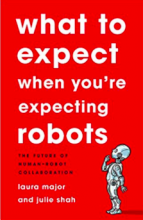
Book description (via Amazon): “‘What to Expect When You’re Expecting Robots’ offers a vision for how robots can survive in the real world and how they will change our relationship to technology. From teaching them manners to robot-proofing public spaces to planning for their mistakes, this book answers every question you didn’t know you needed to ask about the robots on the way.”
Why you should read it: Most robots, to date, have been mere tools, performing simple tasks with significant human oversight. However, the next generation of robots will be truly social, operating on their own in our complex world. Indeed, robots are already wandering the aisle in grocery stores, managing emergency rooms, making deliveries, and zipping through warehouses.
Whether they do these things well, argue robot designers Laura Major and Julie Shah, will depend on whether we’ve built them to know how to behave as social entities. That will require collective effort to ensure “that the new intelligent robots are harnessed to the task of enhancing human well-being.”
My Robot Gets Me: How Social Design Can Make New Products More Human
By: Carla Diana
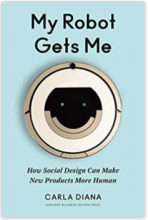
Book description (via Amazon): “Think how commonplace it is now for people to ask Siri for the weather forecast, to deploy Roomba to clean their homes, and to summon Alexa to turn on the lights… But the reality is, these first-generation “smart” products aren’t very smart. Sure, they can be programmed to perform any number of functions, but we’re clearly seeing only the tip of the iceberg in terms of capability and how such products can enhance our lives. How do we take it to the next level? In a word: design.”
Why you should read it: Follow up “What to Expect When You’re Expecting Robots” with this examination into digital product development - coming in March. Head of design for Diligent Robotics, Diana has created a range of digital products, from robots to connected home appliances. She explains how experts like herself can humanize machines – and offers a number of use cases already in development. Diana seems ideally suited to instruction: She writes and lectures on the social impact of emerging technology, wrote the world’s first children’s book on 3D printing, LEO the Maker Prince, and co-hosts the Robopsych Podcast. Here, she delivers an engaging and informative book. It includes clear guidelines for conceptualizing, building, and optimizing products using approaches such as vision imagery, scenario storyboarding, video prototyping, and behavior charting.
User Friendly: How the Hidden Rules of Design Are Changing the Way We Live, Work, and Play
By: Cliff Kuang and Robert Fabricant
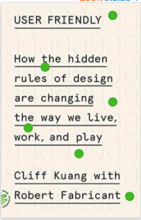
Book description (via MacMillan Publishers): “In ‘User Friendly,’ Cliff Kuang and Robert Fabricant reveal the untold story of a paradigm that quietly rules our modern lives: the assumption that machines should anticipate what we need. Spanning over a century of sweeping changes, from women’s rights to the Great Depression to World War II to the rise of the digital era, this book unpacks the ways in which the world has been – and continues to be – remade according to the principles of the once-obscure discipline of user-experience design.”
Why you should read it: This book comes with some serious accolades: “User-friendliness is the cognitive lubricant that makes us love the stuff we use,” says Ellen Lupton, author of ‘Beautiful Users: Designing for People.’ “This fascinating book unveils how – and why – that love was crafted.” Design thinking guru and CEO of IDEO Tim Brown calls this book “compulsory reading for the current age, in which business and society have turned to design in pursuit of growth and change. But design means little without empathy, and this book lays out a remarkable tale of how that insight became truth.” In light of the tremendous changes of 2020 and 2021, the book may offer even greater value to IT leaders now. (And speaking of design, this offering is now available in paperback, in time for some post-holiday reading.)
Reality Check: How Immersive Technologies Can Transform Your Business
By: Jeremy Dalton
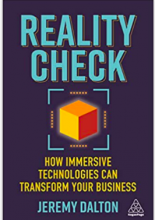
Book description (via Amazon): “Augmented reality (AR) and virtual reality (VR) are part of a new wave of immersive technologies that offer huge opportunities for businesses, across industries and regardless of their size. Most people think of AR or VR as a new development in video gaming like Pokemon GO, or an expensive marketing campaign by the Nikes of the world. The truth is, businesses of any size can put these new technologies to immediate use in areas that include training and development, customer experience and design, as well as data and information management. Reality Check dispels the common misconceptions of AR and VR, such as them being too expensive or not easily scalable, and details how business leaders can integrate them into their business to deliver more efficient, cost-sensitive and exciting business solutions.”
Why you should read it: Immersive technologies have the power to transform every aspect of the enterprise, from marketing and sales to service and support. And in the socially distanced world of the near future, AR and VR are more attractive than ever. PwC’s Dalton has become a well-known evangelist for immersion, spreading the news of its potential for some time. He offers exclusive case studies from Lloyds Banking Group, Honeywell, and IKEA to showcase the practical uses of immersive technologies in day-to-day business, highlighting immediate benefits in the areas of design, training, data and information, and telepresence.
Let’s look at five more must-read books:







